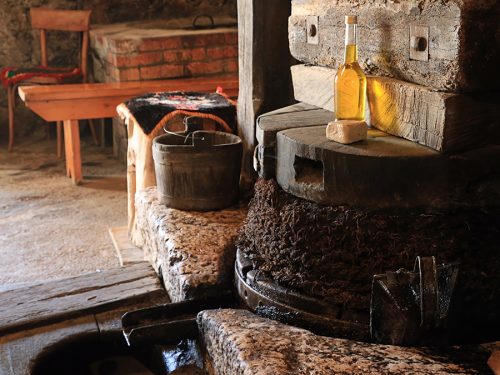You can purchase a 250ml bottle of the maple vinegar for $10 a bottle. The funds raised from this venture will help with our general expenses. It can be shipped across the country or elsewhere.
-
 Maple vinegar is made by fermenting partially boiled maple sap until it turns to vinegar. This takes several weeks. The vinegar is then aged for a year or more in an oak barrel to enhance the flavour. It has a unique flavour and is excellent for making salad dressings or sauces using your favourite oils and spices. We have partnered with Fortune Farms from the Almonte area who have been making maple syrup since the 1850s in the Eastern Ontario region.
Maple vinegar is made by fermenting partially boiled maple sap until it turns to vinegar. This takes several weeks. The vinegar is then aged for a year or more in an oak barrel to enhance the flavour. It has a unique flavour and is excellent for making salad dressings or sauces using your favourite oils and spices. We have partnered with Fortune Farms from the Almonte area who have been making maple syrup since the 1850s in the Eastern Ontario region. -

We have partnered with Fortune Farms from the Almonte area who have been making maple syrup since the 1850s in the Eastern Ontario region.
You can purchase 500ml bottles of either golden, amber or dark for $15 a bottle. The funds raised from this venture will help with our general expenses. The syrup can be shipped across the country or elsewhere. -

We have partnered with Fortune Farms from the Almonte area who have been making maple syrup since the 1850s in the Eastern Ontario region.
You can purchase 1 litre bottles of either golden, amber or dark for $25 a bottle. The funds raised from this venture will help with our general expenses. The syrup can be shipped across the country or elsewhere. -

The 2025 Workers History Museum Calendar pays tribute to the transformative photography and legacy of the Armenian-Canadian photographers Malak and Yousuf Karsh.
The ideas of mentorship, skill development, and shared generational knowledge are represented in the relationship between the Karsh brothers and reflected in the photographs we have selected. They highlight the value of experiential learning in the trades, the arts, and the sciences. These forms of teaching and learning can be found in some way or another in all forms of work, demonstrating that collective memory is one of humanity’s greatest guides.
Cost : $10 each plus postage $5 5 or more $8 each plus postage Contact treasurer@workershistorymuseum.ca for mailing costs for bulk orders. -
 The story of the ON-To-Ottawa Trek During the Great Depression, the Canadian Government established the Unemployment Relief Scheme. It was a nationwide system of camps for single, unemployed men. The beneficiaries of the program worked on road construction and other physically demanding projects, in exchange for room and board and 20 cents a day. In 1935, about 1,500 men from various British Columbia camps went on strike in demand for better working conditions. After a few weeks of protests, and encouraged by many expressions of support from the community, they decided to go to Ottawa to lay their demands before the Prime Minister. It was the beginning of the On-To-Ottawa Trek, a journey that has been a source of inspiration to the workers’ movement in Canada for more than eight decades.
The story of the ON-To-Ottawa Trek During the Great Depression, the Canadian Government established the Unemployment Relief Scheme. It was a nationwide system of camps for single, unemployed men. The beneficiaries of the program worked on road construction and other physically demanding projects, in exchange for room and board and 20 cents a day. In 1935, about 1,500 men from various British Columbia camps went on strike in demand for better working conditions. After a few weeks of protests, and encouraged by many expressions of support from the community, they decided to go to Ottawa to lay their demands before the Prime Minister. It was the beginning of the On-To-Ottawa Trek, a journey that has been a source of inspiration to the workers’ movement in Canada for more than eight decades. -
 Our 2024 Workers’ History Museum calendar celebrates worker’ houses and homes. While of course all heritage houses were built by workers, it is striking how few that were both built and lived in by workers are protected from development. Few have even been photographed and archived. We hope our calendar will be a small step in preserving this heritage. We know that some of the houses and homes we feature may not be with us for much longer. We want to celebrate those workers whose trades or hard-learned skills created beautiful and functional spaces in our city before they are gone forever. Cost : $10 each plus postage $5 5 or more $8 each plus postage Contact treasurer@workershistorymuseum.ca for mailing costs for bulk orders.
Our 2024 Workers’ History Museum calendar celebrates worker’ houses and homes. While of course all heritage houses were built by workers, it is striking how few that were both built and lived in by workers are protected from development. Few have even been photographed and archived. We hope our calendar will be a small step in preserving this heritage. We know that some of the houses and homes we feature may not be with us for much longer. We want to celebrate those workers whose trades or hard-learned skills created beautiful and functional spaces in our city before they are gone forever. Cost : $10 each plus postage $5 5 or more $8 each plus postage Contact treasurer@workershistorymuseum.ca for mailing costs for bulk orders. -
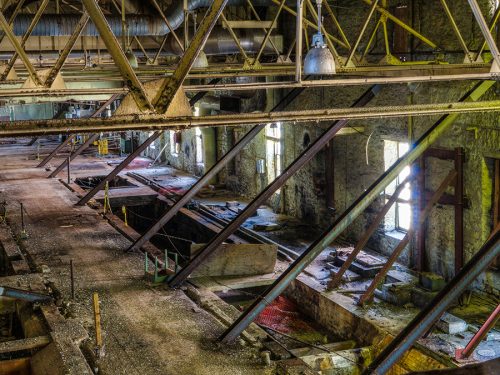 Lumber mills began to appear in the early 19th century at the Chaudière Falls, in the heart of what would one day be the Cities of Ottawa and Hull / Gatineau. For most of the 20th Century, the site was dominated by the E.B. Eddy Pulp and Paper Mills. This is one of the oldest buildings on the site, viewed from a loft which overlooks the space where huge paper machines once stood.
Lumber mills began to appear in the early 19th century at the Chaudière Falls, in the heart of what would one day be the Cities of Ottawa and Hull / Gatineau. For most of the 20th Century, the site was dominated by the E.B. Eddy Pulp and Paper Mills. This is one of the oldest buildings on the site, viewed from a loft which overlooks the space where huge paper machines once stood. -
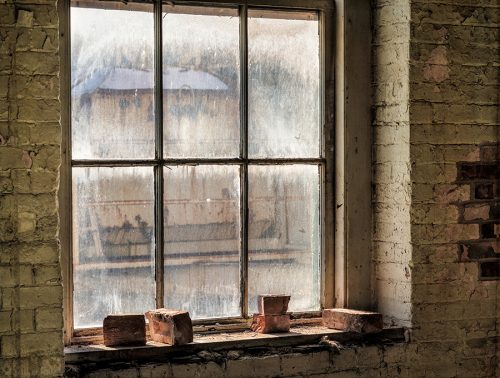 While most images collected were utilitarian record shots, the photographers were alert for magical moments where light and composition offered a unique artistic photograph, and were encouraged to pause to capture it. The moody lighting of this winter day, combined with the brickwork texture and colour, was one of those moments, alertly spotted and skillfully captured by photographer Raymond Massé.
While most images collected were utilitarian record shots, the photographers were alert for magical moments where light and composition offered a unique artistic photograph, and were encouraged to pause to capture it. The moody lighting of this winter day, combined with the brickwork texture and colour, was one of those moments, alertly spotted and skillfully captured by photographer Raymond Massé. -
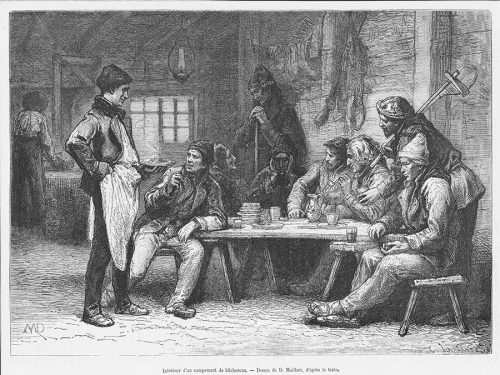 This somewhat misleading image was published to accompany an article by a correspondent to one of the many French popular weeklies of the 1870s. Since the artist was working "d'après le texte", he presumably had never been to Canada, much less a lumber camp. This may be why the tidy and well-groomed lumberjacks are accommodated in a remarkably spacious, well-built building with fine dishware on the table. In fact, everything about the image suggests a French village inn of the period. Still, it is a charming depiction of how Europeans envisaged the life of Canadian lumbermen as it might have been.
This somewhat misleading image was published to accompany an article by a correspondent to one of the many French popular weeklies of the 1870s. Since the artist was working "d'après le texte", he presumably had never been to Canada, much less a lumber camp. This may be why the tidy and well-groomed lumberjacks are accommodated in a remarkably spacious, well-built building with fine dishware on the table. In fact, everything about the image suggests a French village inn of the period. Still, it is a charming depiction of how Europeans envisaged the life of Canadian lumbermen as it might have been. -
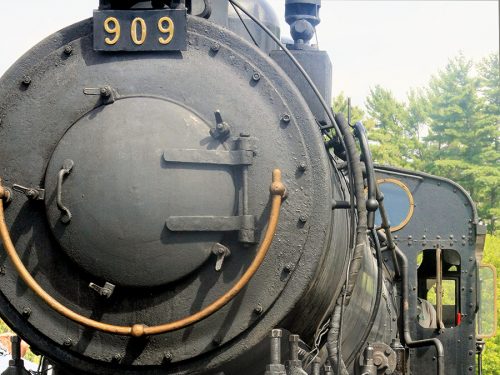 Then for a brief few years, a steam passenger train service once again reappeared in Ottawa. It featured this locomotive, built in 1907 in Sweden. Starting in 1992, the Hull-Chelsea-Wakefield Steam train took locals and visitors on a day trip up the Gatineau River to Wakefield. It used tracks originally built by the Ottawa and Gatineau Valley Railway in 1891. Taken over by the CPR, the route had seen passenger and freight service until the late 1960s, after which the town of Chelsea had preserved the line in anticipation of an opportunity such as the steam train. Sadly, flooding in 2011 damaged the line beyond economical repair and ended the popular excursion. The passenger coaches were scrapped, but the locomotive can still be seen in the Dalton Ecological Park in Gatineau, Quebec.
Then for a brief few years, a steam passenger train service once again reappeared in Ottawa. It featured this locomotive, built in 1907 in Sweden. Starting in 1992, the Hull-Chelsea-Wakefield Steam train took locals and visitors on a day trip up the Gatineau River to Wakefield. It used tracks originally built by the Ottawa and Gatineau Valley Railway in 1891. Taken over by the CPR, the route had seen passenger and freight service until the late 1960s, after which the town of Chelsea had preserved the line in anticipation of an opportunity such as the steam train. Sadly, flooding in 2011 damaged the line beyond economical repair and ended the popular excursion. The passenger coaches were scrapped, but the locomotive can still be seen in the Dalton Ecological Park in Gatineau, Quebec. -
 Among the countless small objects left behind in a supervisory office was this set of keys that once controlled access to clocks, cabinets and pumps. While unremarkable at the time they were photographed, a visual record of such basic workplace technology as it existed in the early twenty-first century and earlier might not be preserved were it not for the efforts of the Workers' History Museum and its volunteers.
Among the countless small objects left behind in a supervisory office was this set of keys that once controlled access to clocks, cabinets and pumps. While unremarkable at the time they were photographed, a visual record of such basic workplace technology as it existed in the early twenty-first century and earlier might not be preserved were it not for the efforts of the Workers' History Museum and its volunteers.

